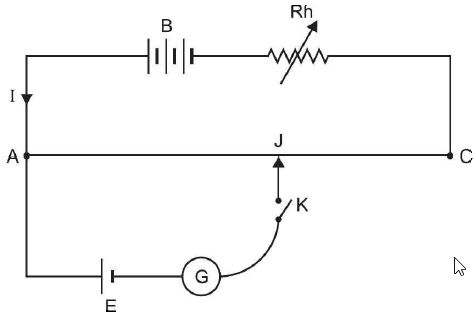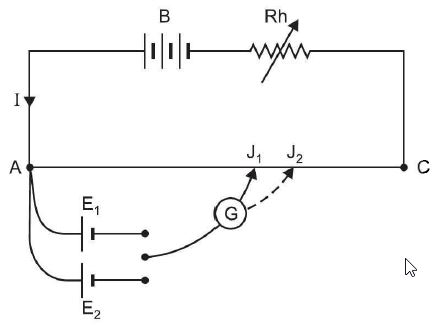Electrical Engineering ⇒ Topic : D.C. Potentiometer
|
|
| David
| |
D.C. Potentiometer A potentiometer is a device used to measure the e.m.f of a voltage source or p. d. between two points in an electrical circuit. It basically measures the potential difference but on this basis, it can be used to make several other measurements. A potentiometer uses null point method (described below) and has the advantage of being able to measure the potential difference of a source without drawing any current from it. Hence it can be used to measure the e.m.f. of a source directly. Principle. If a wire of uniform area of cross-section is carrying a steady current, then fall in potential across it is uniform and voltage drop between any two points on the wire is directly proportional to the distance between these points. figure (a) Voltage drop, V = I r l where I = steady cun-ent through the wire r = resistance per unit length of wire L = length of wire over which drop occurs Now, / and r are constant so that V ∝ L. Theory. Fig. (a) shows a simple type of d.c. potentiometer. It consists of german silver or manganin wire AC (called slide wire) of uniform area of cross-section. A battery B (called driver battery) sends a steady current through the slide wire. The slide-wire current can be changed with the help of rheostat Rh. The cell whose e.m.f. E is to be measured is connected in series with a galvanometer G and a key K. Note that positive terminals of battery B and the cell must be connected together. The jockey J can slide along the slide wire AC and can make contact at any point on the wire. Suppose that r is the resistance per unit length of the slide wire AC. With key K open, the rheostat Rh is set at the desired position to obtain suitable steady current I in the slide wire AC. Now key K is closed so that the cell is put in the circuit. The jockey is moved over the slide wire till we get a point f on the wire at which the galvanometer reads zero. Under this condition (i.e., zero galvanometer current), we say that null-point or balance point is reached. At null point, the current in the slide wire is again I. It is clear that at null point, the e.m.f. E of the cell just balances the potential difference across the length AJ ' (= 1) of the slide wire i.e., E = Voltage drop across length Al = I r l Thus e.m.f. E of the cell can be determined Note that at null point, there is no current in the cell so that voltage drop across its internal resistance is zero. Therefore, the potentiometer measures the e.m.f. of the cell. Further, at null point, there is no change in circuit current (i.e., current in the slide wire in this case). This is the main advantage of null point method. Comparison of e.m.f.s of two cells. Fig. (b) shows the arrangement for comparing the e.m.f.s El and E2 of the two cells with a potentiometer. Note that positive terminals of the cells and the positive terminal of the driver battery B must be connected together. The cells are joined to the galvanometer G through a two-way key. figure (b) With both cells out of the circuit, the rheostat Rh is set at the desired position to obtain suitable steady current I in the slide wire AC. The rheostat setting is not to be changed throughout the experiment otherwise wrong results will be obtained. First, only cell of e.m.f. El is put in the circuit. The jockey is moved on the slide wire till galvanometer reads zero (null point). Suppose null point is obtained when jockey is at point J1 on the slide wire. If AJI= l1, then, El = I r l1 where r = resistance per unit length of slide wire. Now, only cell E2 is put in the circuit and null point is obtained when jockey is at point J2 on the slide wire. If AJ2= l2, then, Since the lengths l1 and 12 are known, the ratio E2/E1 can be determined Further, if the e.m.f. of one cell is known, the e.m.f. of the other cell can be found out. Note. One important disadvantage of potentiometer is that it cannot measure a potential difference greater than the e.m.f. of the driver battery B (about 2 V). For measuring higher voltages, volt ratio box is used in conjunction with the potentiometer | |
|
| |
!! OOPS Login [Click here] is required for more results / answer



